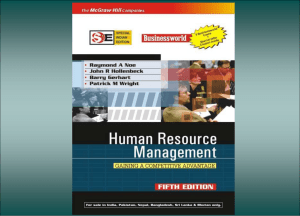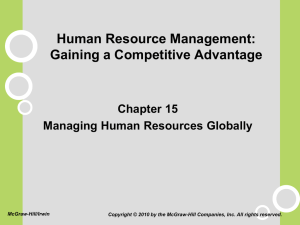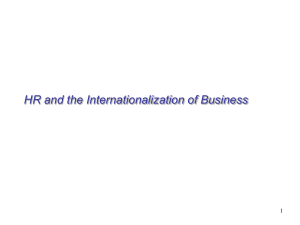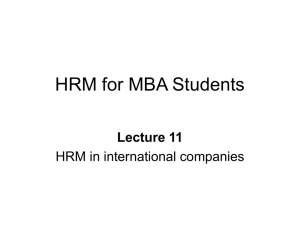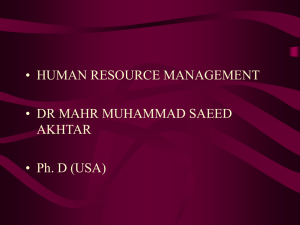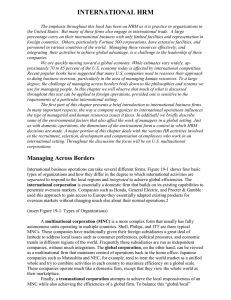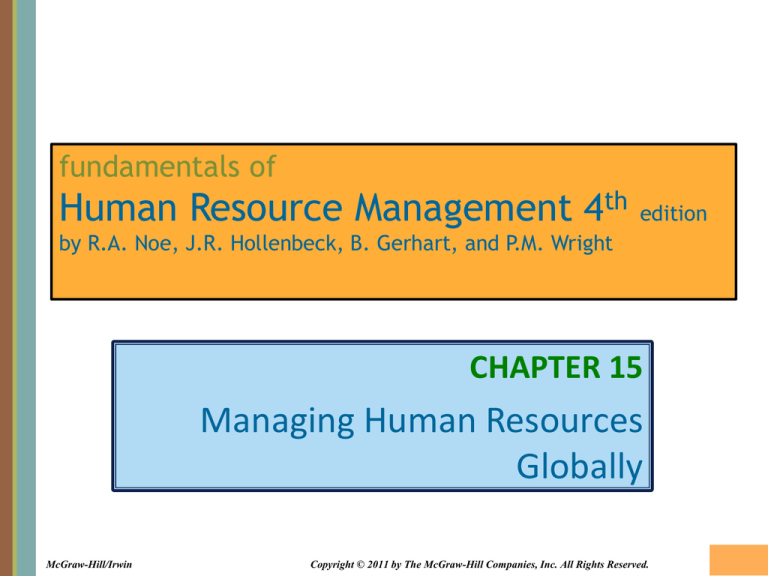
fundamentals of
Human Resource Management 4th
edition
by R.A. Noe, J.R. Hollenbeck, B. Gerhart, and P.M. Wright
CHAPTER 15
Managing Human Resources
Globally
McGraw-Hill/Irwin
Copyright © 2011 by The McGraw-Hill Companies, Inc. All Rights Reserved.
15-1
What Do I Need to Know?
1. Summarize how the growth in international
business activity affects human resource
management.
2. Identify the factors that most strongly
influence HRM in international markets.
3. Discuss how differences among countries
affect HR planning at organizations with
international operations.
15-2
What Do I Need to Know? (continued)
4. Describe how companies select and train
human resources in a global labor market.
5. Discuss challenges related to compensating
employees from other countries.
6. Explain how employers prepare managers for
international assignments and for their
return home.
15-3
HRM in a Global Environment
• The environment in which organizations
operate is rapidly becoming a global one.
• Foreign countries can provide a business with
new markets.
• Companies set up operations overseas
because of lower labor costs.
• Technology makes it easier for companies to
spread work around the globe.
15-4
As companies in the
United States and
Britain cut software
jobs and outsource to
other countries in
order to drive down
costs, countries such
as India continue to
see employment rise.
15-5
HRM in a Global Environment (continued)
• Global activities are simplified and
encouraged by trade agreements among
nations.
• As these trends and arrangements encourage
international trade, they increase and change
demands on human resource management.
– Organizations need employees who understand the
customers and suppliers in foreign countries.
– Organizations need to understand the laws and
customs that apply to employees in other countries.
15-6
Employees in an International Workforce
• Parent-country national – employee who was born
and works in the country in which an organization’s
headquarters is located.
• Host-country national – employee who is a citizen of
the country (other than parent country) in which an
organization operates a facility.
• Third-country national – employee who is a citizen
of a country that is neither the parent country nor
the host country of the employer.
15-7
Employees in an International Workforce
(continued)
• When organizations operate overseas, they
hire a combination of parent-country
nationals, host-country nationals, or thirdcountry nationals.
• Expatriates – employees assigned to work in
another country.
15-8
Figure 15.1: Levels of Global Participation
15-9
Employers in the Global Marketplace
• International organization – an organization that
sets up one or a few facilities in one or a few foreign
countries.
• Multinational company – an organization that builds
facilities in a number of different countries in an
effort to minimize production and distribution costs.
• Global organization – an organization that chooses
to locate a facility based on the ability to effectively,
efficiently, and flexibly produce a product or service
using cultural differences as an advantage.
15-10
Test Your Knowledge
• Hans works for a company who’s headquartered in
France and has foreign operations in Germany, only.
Hans is a citizen of the Netherlands. Which of the
following is most likely true?
a) Hans works for a domestic company and is from the parent
country.
b) Hans works for a multinational company and is from the
host country.
c) Hans works for a global company and is from a third
country.
d) Hans works for an international company and is from a third
country.
15-11
Transnational HRM System
• Transnational HRM system:
– makes decisions from a global perspective
– includes managers from many countries
– based on ideas contributed by people
representing a variety of cultures
• Decisions that are the outcome of a
transnational HRM system balance uniformity
with flexibility.
15-12
Factors Affecting HRM in
International Markets
Education
Economic
Systems
Culture
Global
HRM
PoliticalLegal
Systems
15-13
Culture
• Culture – a community’s set of shared
assumptions about how the world works and
what ideals are worth striving for.
• Culture can greatly affect a country’s laws.
• Culture influences what people value, so it
affects people’s economic systems and efforts
to invest in education.
• Culture often determines the effectiveness of
various HRM practices.
15-14
Culture (continued)
• Cultural characteristics influence the ways
members of an organization behave toward one
another as well as their attitudes toward
various HRM practices.
• Cultures strongly influence the appropriateness
of HRM practices.
• Cultural differences can affect how people
communicate and how they coordinate their
activities.
15-15
Hofstede’s Five Dimensions of Culture
1. Individualism/Collectivism Describes the strength of the relation
between an individual and other individuals in
the society.
2. Power Distance
Concerns the way the culture deals with
unequal distribution of power and defines the
amount of inequality that is normal.
3. Uncertainty Avoidance
Describes how cultures handle the fact that
the future is unpredictable.
4. Masculinity/Femininity
The emphasis a culture places on practices or
qualities that have traditionally been
considered masculine or feminine.
5. Long-term/Short-term
Orientation
Suggests whether the focus of cultural values
is on the future (long term) or the past and
present (short term).
15-16
In Taiwan, a country that is high in
collectivism, coworkers consider
themselves more as group members
instead of individuals.
15-17
Culture (continued)
• Organizations must prepare managers to
recognize and handle cultural differences.
– Recruit managers with knowledge of other
cultures
– Provide training
• For expatriate assignments, organizations may
need to conduct an extensive selection
process to identify individuals who can adapt
to new environments.
15-18
Education and Skill Levels
• Companies with foreign operations locate in
countries where they can find suitable
employees.
• The educations and skill levels of a country’s
labor force affect how and the extent to which
companies want to operate there.
• In countries with a poorly educated
population, companies will limit their
activities to low-skill, low-wage jobs.
15-19
Economic System
• The economic system provides many of the
incentives or disincentives for developing the
value of the labor force.
• In developed countries with great wealth,
labor costs are relatively high. This impacts
compensation and staffing practices.
• Income tax differences between countries
make pay structures more complicated when
they cross national boundaries.
15-20
Political-Legal System
• The country’s laws often dictate the
requirements for HRM practices: training,
compensation, hiring, firing, and layoffs.
• An organization that expands internationally
must gain expertise in the host country’s legal
requirements and ways of dealing with its
legal system.
• Organizations will hire one or more hostcountry nationals to help in the process.
15-21
Human Resource Planning in a
Global Economy
• Human resource planning involves decisions
about where and how many employees are
needed for each international facility.
• Decisions about where to locate include
considerations such as the cost and availability of
qualified workers.
• These considerations must be weighed against
financial and operational requirements.
• Other location decisions involve outsourcing.
15-22
Criteria for Selection of Employees for
Foreign Assignments
1. Competency in the employee’s area of expertise
2. Ability to communicate verbally and nonverbally in
the foreign country
3. Flexibility, tolerance of ambiguity, and sensitivity to
cultural differences
4. Motivation to succeed and enjoyment of challenges
5. Willingness to learn about the foreign country’s
culture, language, and customs
6. Support from family members
15-23
Qualities associated with success in foreign
assignments are the ability to communicate in
the foreign country, flexibility, enjoying a
challenging situation, and support from family
members.
15-24
Figure 15.2: Emotional Cycle Associated
with a Foreign Assignment
15-25
Test Your Knowledge
• Rachel, an expatriate working in Japan is
feeling very uncomfortable in her
surroundings. She often feels as if she has
said the wrong thing. Rachel is most likely in
which emotional stage of expatriation:
a)
b)
c)
d)
Honeymoon
Culture shock
Learning
Adjustment
15-26
Training and Developing a
Global Workforce
• Training and development programs should be
effective for all participating employees,
regardless of their country of origin.
• When organizations hire employees to work in a
foreign country or transfer them to another
country, the employer needs to provide the
employees with training in how to handle the
challenges associated with working in a foreign
country.
15-27
Table 15.1: Effects of Culture on Training
Design
15-28
Test Your Knowledge
• Employees from a high-power distance culture
would feel most comfortable in a training class
that:
a) Involved several group activities with classmates
b) The teacher was the expert and responded
definitively to all questions
c) The teacher acted as a facilitator of group
discussion
d) None of the above
15-29
Delivering Training in Other Countries
• Know your goals – clarify what overseas training is
supposed to achieve.
• Consider international differences among trainees
when developing the training plan.
• Keep an eye on quality – overseas trainers should
meet the same quality standards as training at
headquarters.
• Be clear about standards for confidentiality and
intellectual property.
• Know the local laws that affect training programs.
15-30
Foreign Assignments
• Would you consider taking a foreign
assignment for a 6 months to 1 year duration?
A = Yes B = No
• Before you took on a foreign assignment, what
would you want to know?
15-31
Cross-Cultural Preparation
• This is training to prepare employees and their
family members for an assignment in a foreign
country.
• The training covers all three phases of an
international assignment:
1. Preparation for departure
2. The assignment itself
3. Preparation for the return home
15-32
Performance Management Across
National Boundaries
• When establishing
performance
management methods
in other countries,
organizations have to
consider:
– Legal requirements
– Local business practices
– National cultures
• Differences may
include:
– Which behaviors are
rated
– How and the extent to
which performance is
measured
– Who performs the rating
– How feedback is
required
15-33
Compensating an International Workforce
• Market pay structures can differ substantially
across countries in terms of both pay level and
the relative worth of jobs.
• This creates a dilemma for global companies:
– Should pay levels and differences reflect what
workers are used to in their own countries?
– Should pay levels and differences reflect the
earnings of colleagues in the country of the
facility, or earnings at the company headquarters?
15-34
Figure 15.3: Earnings in Selected
Occupations in Three Countries
15-35
Compensating an International Workforce
(continued)
• Compensation decisions affect a company’s
costs and ability to compete.
• The challenge of competing with organizations
in low-wage countries can be very difficult.
• Decisions about benefits must take into
account the laws of each country involved, as
well as employees’ expectations and values in
those countries.
15-36
Figure 15.4: Average Hours Worked in
Selected Countries
15-37
International Labor Relations
• Labor relations on an international scale involves
differences in laws, attitudes, economic systems,
and differences in negotiation styles.
• Organizations establish overall policies and goals
for labor relations, overseeing labor agreements,
and monitoring labor performance.
• The day-to-day decisions about labor relations
are usually handled by each foreign subsidiary.
15-38
Managing Expatriates:
Selecting Expatriate Managers
• Expatriate managers need technical
competence in the area of operations.
• In addition, many other skills are necessary to
be successful in an overseas assignment:
– Ability to maintain a positive self-image and feeling
of well-being
– Ability to foster relationships with host-country
nationals
– Ability to perceive and evaluate the host country’s
environment accurately
15-39
Topics for Assessing Candidates for
Overseas Assignments
Motivation
Resourcefulness
Health
Adaptability
Language ability
Career Planning
Family Considerations
Financial
15-40
Managing Expatriates:
Preparing Expatriates
•
•
•
•
•
•
Pre-assignment site visit
Job orientation
Country orientation
Culture orientation
Language training
Compensation /
benefits / taxes
counseling
• Housing counseling
• Health care / schools /
shopping / recreation
counseling
• Counseling by returning
expatriates
• Local sponsorship from
host country
15-41
Figure 15.5:
Impressions of
Americans –
Comments by
Visitors to the
United States
15-42
Compensating Expatriates
• Balance sheet approach – this approach
adjusts the manager’s compensation so that it
gives the manager the same standard of living
as in the home country plus extra pay for the
inconvenience of locating overseas.
• This approach involves an effort by the global
organization to ensure that its expatriates are
“made whole.”
15-43
Figure 15.6: The Balance Sheet for
Determining Expatriate Compensation
15-44
Toyko Tops Priciest Cities
15-45
Compensating Expatriates (continued)
• After setting the total pay, the organization
divides this amount into the four components
of the total pay package:
1.
2.
3.
4.
Base salary
Tax equalization allowance
Benefits
Allowances
15-46
Figure 15.7:
International
Assignment
Allowance Form
15-47
Helping Expatriates Return Home
• Repatriation – the process of preparing
expatriates to return home from foreign
assignment.
1. Communication: the expatriate receives
information and recognizes changes at home
while abroad
2. Validation: giving the expatriate recognition for
the overseas service when this person returns
home.
15-48
Summary
• More and more companies are entering international
markets by exporting and operating foreign facilities.
• Organizations therefore need employees who
understand customers and suppliers in other countries.
• They need to understand local laws and customs and
be able to adapt their plans to local situations.
• To do this organizations may hire a combination of
parent-country, host-country, and third-country
nationals.
15-49
Summary (continued)
• A global organization needs a transnational HRM
system, which:
– Makes decisions from a global perspective
– Includes managers from many countries
– Is based on ideas contributed by people representing a
variety of cultures
• The most important influence is the culture of each
market – its set of shared assumptions about how
the world works and what ideals are worth striving
for.
15-50
Summary
• Another influence on international HRM is the
foreign country’s political-legal system.
• A country’s economic system, as well as the
government’s involvement in the economy, is a
strong factor determining HRM practices.
• HR planning involves decisions about where and how
many employees are needed for each international
facility.
• Most foreign operations positions are filled with
host-country nationals.
15-51
Summary (continued)
• Foreign positions are also filled with parent-country
and third-country nationals.
• Pay structures can differ substantially among
countries in terms of pay level and the relative worth
of jobs.
• Laws may dictate differences in benefits packages,
and the value of benefits will differ if a country
requires them or makes them a government service.
15-52
Summary (continued)
• The organization must prepare the manager selected
for an overseas assignment.
• Cross-cultural training for the assignment as well as
preparation for repatriation after the assignment are
critical success factors.
• Communication of changes at home and validation of
a job well done abroad help the expatriate through
the repatriation process.
15-53


